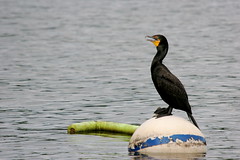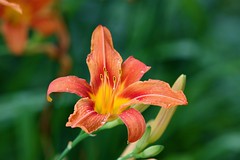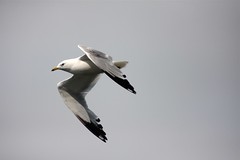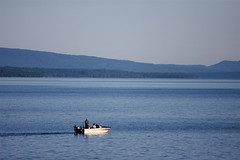 Food, water, and cover are the three essential components of valuable wildlife habitat and all are available on the Point. There are a variety of habitats such as pastures, fields, pine forest, woodland forest, and wetlands that provide for a diversity of wildlife. In addition there are larger wetlands and undeveloped tracts of land contiguous to Thompson’s Point. Seasonal use of the site by human beings is limited primarily to the months of June-September leaving the area free from human intervention for two-thirds of every year.
Food, water, and cover are the three essential components of valuable wildlife habitat and all are available on the Point. There are a variety of habitats such as pastures, fields, pine forest, woodland forest, and wetlands that provide for a diversity of wildlife. In addition there are larger wetlands and undeveloped tracts of land contiguous to Thompson’s Point. Seasonal use of the site by human beings is limited primarily to the months of June-September leaving the area free from human intervention for two-thirds of every year.
Limestone Bluff Cedar-Pine Forest is one of 80 natural community types recognized in Vermont (Sorenson & Popp, 2006). It occurs on the limestone and dolomite bluffs and outcrops found primarily along the shore of Lake Champlain and is dominated by northern white cedar (Thuja occidentalis). This rare community type is also known from New York, Quebec, and Ontario, and similar communities are described from limestone escarpments in the Great Lakes region. The cedars are characteristic of the extreme conditions of bedrock, soil, wind, and a harsh lakefront habitat; they are also indicative of the calcium-rich dolostone bedrock below. The Point is ringed on three sides, the perimeter of the peninsula, with northern white cedar. Some of the cedars are 100 years old (Harris, 1990). It is largely this native tree cover that screens the camps from the Lake.
 Interior to the rim are three types of communities. Predominant are mixed hardwoods including shagbark hickories, butternut, hop-hornbeam, sugar maples, beech and red, white and bur oaks. Inside the forest a habitat has been formed by the underlying mineral rich soil covered by the hardwood leaves which is perfect for columbine, trillium, jack-in-the-pulpit, trout lilies, wild ginger, ferns and Indian pipes.
Interior to the rim are three types of communities. Predominant are mixed hardwoods including shagbark hickories, butternut, hop-hornbeam, sugar maples, beech and red, white and bur oaks. Inside the forest a habitat has been formed by the underlying mineral rich soil covered by the hardwood leaves which is perfect for columbine, trillium, jack-in-the-pulpit, trout lilies, wild ginger, ferns and Indian pipes.
Natural re-seeding does take place. For example, the Ansley’s have a butternut tree about 7 cm diameter which was seeded from their neighbor’s tree that died from a blight. Snags are left. Much of the area is left in a natural overgrown state. There are even a few flower gardens cultivating native species; purple vetch for example is lushly maintained at the Ansley’s.
There are also smaller hemlock and white pine forests. And the center of the Point is used for agriculture, including the grazing of milk cows, and fields of hay and oats that have been on-going for about the last century. The fields are laden with alien flower species. Near the roadsides are escaped garden plants. The lawns and exotic flowering shrubs and flowerbeds are evidence of human gardeners influencing the herbaceous and shrub vegetation.
As in much of the warm Champlain Valley, invasive exotic species are a threat to the integrity of natural communities and the value of the area as wildlife habitat. Limestone Bluff Cedar-Pine Forests are especially sensitive to invasion by exotic species after disturbance due to the calcium-rich bedrock on which the community occurs (Harris, 1990). The most invasive exotic species on the Point (and in the Champlain Valley) are: multiflora rose, Japanese barberry, two species of buckthorn, honeysuckle, purple loosestrife and Japanese knotweed (Dave Adams, personal communication, 22 January 2008). The latter four are considered a “serious threat to the state” (Vermont Agency of Natural Resources, 2003, p.2). At the Point non-native invasive exotics are widespread and these plants are suppressing the regeneration of native seedlings.
 Hank Kaestner has identified 187 species of birds on the Point. Most were identified during the months of May-September, but 68 were migrants passing by during the months of October and November. The Split Rock Channel is renowned among birders because the migrants who travel through it can be easily seen. During several mid-October to mid-December weekends in 2005 for example, 46,150 ring-billed gulls, 17,554 snow geese, 6,311 Canada geese, and 1,356 common loons were counted migrating (personal communication, Dick Lavelle and Ted Murin, Lake Watch, 2005). “They wait for the wind. During one day in the autumn of 2007, when the winds were about 20 miles an hour, north by northwest, about 15,000 terns flew by “(personal communication, January 22, 2008). Loons, bald eagles, and ospreys—all species that were extirpated are now making a comeback. Pileated woodpeckers, which were not seen on the Point for many years are now nesting regularly. Mallard ducks have also been nesting for the past ten years after a hiatus of many decades. Far fewer songbirds nesting on the porches may be a sign of better nesting places as the old growth trees mature, or fewer songbirds. Deer, foxes, and rabbits can be seen everyday.
Hank Kaestner has identified 187 species of birds on the Point. Most were identified during the months of May-September, but 68 were migrants passing by during the months of October and November. The Split Rock Channel is renowned among birders because the migrants who travel through it can be easily seen. During several mid-October to mid-December weekends in 2005 for example, 46,150 ring-billed gulls, 17,554 snow geese, 6,311 Canada geese, and 1,356 common loons were counted migrating (personal communication, Dick Lavelle and Ted Murin, Lake Watch, 2005). “They wait for the wind. During one day in the autumn of 2007, when the winds were about 20 miles an hour, north by northwest, about 15,000 terns flew by “(personal communication, January 22, 2008). Loons, bald eagles, and ospreys—all species that were extirpated are now making a comeback. Pileated woodpeckers, which were not seen on the Point for many years are now nesting regularly. Mallard ducks have also been nesting for the past ten years after a hiatus of many decades. Far fewer songbirds nesting on the porches may be a sign of better nesting places as the old growth trees mature, or fewer songbirds. Deer, foxes, and rabbits can be seen everyday.
 The fishing grounds around Thompson’s Point however, have not recovered. As it has for over almost all of its 130 years, a 2003 article in Field and Stream declared Lake Champlain to be one of “America’s best fishing spots.” Only the definition of a good fishing spot has changed – now it is “Not just big fish, but waters of extraordinary beauty, diversity and unique personalities” (Glenn & Teetor, 2005). Even in the last three decades fishing has decreased markedly in that those people who formerly fished rarely bother to go out now, and when they do, don’t expect to catch much. Most of the fish eaten by people around the Lake these days is from elsewhere. Even the species found in the Lake have changed in that some have been introduced and species that were formerly plentiful are now rare. The number of introduced species has steadily increased every decade since the 1930s, reaching a peak of 13 in the decade of the 1990s (Lake Champlain Basin Program, 2005). Zebra mussels for example were first discovered in Lake Champlain in 1993 and since then have thoroughly covered rocks, moorings, shipwrecks in deep water, municipal water facilities, and docks throughout the Lake (Hauser & Lynch, 2005). Now, to wade at Thompson’s Point it is necessary to wear shoes to protect one’s feet against their sharp shells. Relics of cement docks that are no longer allowed to be built are crumbling underwater, covering natural habitat, and providing additional substrate for zebra mussels. The evidence these days of native mussels consists of empty shells.
The fishing grounds around Thompson’s Point however, have not recovered. As it has for over almost all of its 130 years, a 2003 article in Field and Stream declared Lake Champlain to be one of “America’s best fishing spots.” Only the definition of a good fishing spot has changed – now it is “Not just big fish, but waters of extraordinary beauty, diversity and unique personalities” (Glenn & Teetor, 2005). Even in the last three decades fishing has decreased markedly in that those people who formerly fished rarely bother to go out now, and when they do, don’t expect to catch much. Most of the fish eaten by people around the Lake these days is from elsewhere. Even the species found in the Lake have changed in that some have been introduced and species that were formerly plentiful are now rare. The number of introduced species has steadily increased every decade since the 1930s, reaching a peak of 13 in the decade of the 1990s (Lake Champlain Basin Program, 2005). Zebra mussels for example were first discovered in Lake Champlain in 1993 and since then have thoroughly covered rocks, moorings, shipwrecks in deep water, municipal water facilities, and docks throughout the Lake (Hauser & Lynch, 2005). Now, to wade at Thompson’s Point it is necessary to wear shoes to protect one’s feet against their sharp shells. Relics of cement docks that are no longer allowed to be built are crumbling underwater, covering natural habitat, and providing additional substrate for zebra mussels. The evidence these days of native mussels consists of empty shells.
Not all the Lake news is bad. The Lake Champlain Restoration Program, which began in 1973, has restored landlocked Atlantic salmon and lake trout to Lake Champlain and a 23 pound lake trout was caught near the Point in 1996 (Demarest, 1997). Sturgeon are endangered in Vermont, but a restoration program has begun through the Fish and Wildlife Department.
Next | Sections 1 | 2 | 3 | 4 | 5 | 6 | 7 | 8 | 9 | 10 Appendicies 1 | 2 | 3 Home



